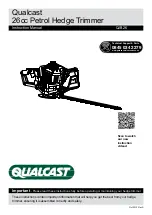
9
IE
NI
GB
footing and balance at all times.
This enables better control of the power
tool in unexpected situations.
f)
Dress properly. Do not wear
loose clothing or jewellery. keep
your hair, clothing and gloves
away from moving parts.
Loose
clothes, jewellery or long hair can be
caught in moving parts.
g) If dust extraction and collection
devices can be installed, make
sure that these are connected and
used correctly.
Using a dust collector
can reduce hazards caused by dust.
4) POWER TOOl USE AND CARE
In this way you avoid accidents
and injuries
:
a)
Do not force the power tool.
Use the correct power tool for
your application.
The correct pow
-
er tool will do the job better and safer
at the rate for which it was designed.
b)
Do not use the power tool if the
switch does not turn it on and
off.
Any power tool that cannot be
controlled with the switch is dangerous
and must be repaired.
c)
Remove the plug from the wall
socket and/or remove the re-
chargeable battery before you
change the settings of the de-
vice, change accessory parts or
put away the device.
Such preven-
tive safety measures reduce the risk of
starting the power tool accidentaIly.
d)
Store idle power tools out of
the reach of children and do not
allow persons unfamiliar with
the power tool or these instruc-
tions to operate the power tool.
Power tools are dangerous in the
hands of untrained users.
e)
Maintain power tools. Check
for misalignment or binding
of moving parts, breakage of
parts and any other condition
that may affect the power tool’s
operation. If damaged, have
the power tool repaired before
use.
Many accidents are caused by
poorly maintained power tools.
f)
keep cutting tools sharp and
clean.
Properly maintained cutting
tools with sharp cutting edges are less
Iikely to bind and are easier to control.
g)
Use the power tool, accessories
and tool bits etc. in accordance
with these instructions, tak-
ing into account the working
conditions and the work to be
performed.
Use of the power tool for
operations different from those intended
could result in a hazardous situation.
5) CAREfUl HANDlING AND USE
Of bATTERy DEvICES
a) Charge the batteries only in
chargers that are recommended
by the manufacturer.
Risk of fire if a
charger that is suitable for a specific type
of battery is used with other batteries.
b) In the power tools, use only the
batteries designed for the pur-
pose.
The use of other batteries may
result in injuries and risk of fire.
c) keep the unused battery away
from paper clips, coins, keys,
nails, screws and other small
metal objects, which could
cause bridging of the contacts.
A short circuit between the battery
contacts may cause burns or fire.
d) If used incorrectly, liquid may
leak from the battery. Avoid
Summary of Contents for PTHSA 20-Li A2
Page 3: ...3 A B 1 2 3 4 5 6 7 8 16 9 10 10 12 13 14 15 11 11 19 12a 12b 2 6 17 18 5...
Page 70: ...70...
Page 71: ...71...
Page 76: ...76...
Page 78: ...C 6 7 8 D 1 2 3...
Page 79: ......










































